The Study on Culicoides: The Environment They Live in and Trypanosomatids They Coexist
Simple Summary
Abstract
1. Introduction
2. Materials and Methods
2.1. Insect Trapping
2.2. Culicoides Identification
2.3. Microscopy of Parasites
2.4. PCR-Based Screening and Sequencing
2.5. Statistical Analysis
3. Results
3.1. Seasonal Culicoides Abundance
3.2. Relationships Between Biting Midge Abundance and Meteorological Parameters
3.3. Prevalence of Trypanosomatids in Culicoides
3.4. Seasonality of Trypanosomatid Infection
4. Discussion
5. Conclusions
Author Contributions
Funding
Data Availability Statement
Acknowledgments
Conflicts of Interest
References
- Elbers, A.R.W.; Koenraadt, C.; Meiswinkel, R. Mosquitoes and Culicoides biting midges: Vector range and the influence of climate change. Rev. Sci. Tech. 2015, 34, 123–137. [Google Scholar] [CrossRef]
- Mellor, P.S.; Boorman, J.; Baylis, M. Culicoides biting midges: Their role as arbovirus vectors. Annu. Rev. Entomol. 2000, 45, 307–340. [Google Scholar] [CrossRef]
- Carpenter, S.; Groschup, M.H.; Garros, C.; Felippe-Bauer, M.L.; Purse, B.V. Culicoides biting midges, arboviruses and public health in Europe. Antivir. Res. 2013, 100, 102–113. [Google Scholar] [CrossRef]
- Svobodová, M.; Dolnik, O.V.; Čepička, I.; Rádrová, J. Biting midges (Ceratopogonidae) as vectors of avian trypanosomes. Parasites Vectors 2017, 10, 224. [Google Scholar] [CrossRef]
- Bernotienė, R.; Iezhova, T.A.; Bukauskaitė, D.; Chagas, C.R.F.; Kazak, M.; Valkiūnas, G. Development of Trypanosoma everetti in Culicoides biting midges. Acta Trop. 2020, 210, 105555. [Google Scholar] [CrossRef]
- Bukauskaitė, D.; Iezhova, T.A.; Ilgūnas, M.; Valkiūnas, G. High susceptibility of the laboratory-reared biting midges Culicoides nubeculosus to Haemoproteus infections, with review on Culicoides species that transmit avian haemoproteids. Parasitology 2019, 146, 333–341. [Google Scholar] [CrossRef]
- Žiegytė, R.; Markovets, M.Y.; Bernotienė, R.; Mukhin, A.; Iezhova, T.A.; Valkiūnas, G.; Palinauskas, V. The widespread biting midge Culicoides impunctatus (Ceratopogonidae) is susceptible to infection with numerous Haemoproteus (Haemoproteidae) species. Parasites Vectors 2017, 10, 397. [Google Scholar] [CrossRef]
- Žiegytė, R.; Bernotienė, R.; Palinauskas, V.; Valkiūnas, G. Haemoproteus tartakovskyi (Haemoproteidae): Complete sporogony in Culicoides nubeculosus (Ceratopogonidae), with implications for avian haemoproteid experimental research. Exp. Parasitol. 2016, 160, 17–22. [Google Scholar] [CrossRef]
- Chandenier, J.; Landau, I.; Baccam, D. Experimental transmission of passeriform trypanosomes by Culicoides. Ann. Parasitol. Hum. Comp. 1991, 66, 9–17. [Google Scholar] [CrossRef]
- Miltgen, F.; Landau, I. Culicoides nubeculosus, an experimental vector of a new trypanosome from psittaciforms: Trypanosoma bakeri n. sp. Ann. Parasitol. Hum. Comparée 1982, 57, 423–428. [Google Scholar] [CrossRef]
- Bukauskaitė, D.; Bernotienė, R.; Iezhova, T.A.; Valkiūnas, G. Mechanisms of mortality in Culicoides biting midges due to Haemoproteus infection. Parasitology 2016, 143, 1748–1754. [Google Scholar] [CrossRef]
- Boorman, J. The maintenance of laboratory colonies of Culicoides variipennis (Coq.), C. nubeculosus (Mg.) and C. riethi Kieff. (Diptera, Ceratopogonidae). Bull. Entomol. Res. 1974, 64, 371–377. [Google Scholar] [CrossRef]
- Carpenter, S.; Mordue (Luntz), A.J.; Mordue, W. Oogenesis and laboratory survival in the Scottish biting midge Culicoides impunctatus. Physiol. Entomol. 2006, 31, 89–93. [Google Scholar] [CrossRef]
- Semenza, J.C.; Suk, J.E. Vector-borne diseases and climate change: A European perspective. FEMS Microbiol. Lett. 2018, 365, fnx244. [Google Scholar] [CrossRef]
- Kovats, R.S.; Campbell-Lendrum, D.H.; McMichel, A.J.; Woodward, A.; Cox, J.S.H. Early effects of climate change: Do they include changes in vector-borne disease? Philos. Trans. R. Soc. B 2001, 356, 1057–1068. [Google Scholar] [CrossRef]
- Lilliew, T. The flight range of Culicoides variipennis (Diptera: Ceratopogonidae). Can. Entomol. 1981, 113, 419–426. [Google Scholar] [CrossRef]
- Werner, D.; Groschupp, S.; Bauer, C.; Kampen, H. Breeding habitat preferences of major Culicoides species (Diptera: Ceratopogonidae) in Germany. Int. J. Environ. Res. Public Health 2020, 17, 5000. [Google Scholar] [CrossRef]
- Sellers, R.F. Weather, host and vector—Their interplay in the spread of insect-borne animal virus diseases. Epidemiol. Infect. 1980, 85, 65–102. [Google Scholar] [CrossRef]
- Mullen, G.R.; Murphree, C.S. Biting Midges (Ceratopogonidae). In Medical and Veterinary Entomology; Academic Press: Cambridge, MA, USA, 2019; pp. 213–236. [Google Scholar] [CrossRef]
- Sanders, C.J.; Shortall, C.R.; Gubbins, S.; Burgin, L.; Gloster, J.; Harrington, R.; Reynolds, D.R.; Mellor, P.S.; Carpenter, S. Influence of season and meteorological parameters on flight activity of Culicoides biting midges. J. Appl. Ecol. 2011, 48, 1355–1364. [Google Scholar] [CrossRef]
- Bernotienė, R.; Bartkevičienė, G.; Bukauskaitė, D. The flying activity of biting midges (Ceratopogonidae: Culicoides) in Verkiai Regional Park, southeastern Lithuania. Parasitoly Res. 2021, 120, 2323–2332. [Google Scholar] [CrossRef]
- Gardner, S.L.; Gardner, S.A. Concepts in Animal Parasitology; Zea Books: Lincoln, NE, USA, 2024; Available online: https://digitalcommons.unl.edu/parasittext/ (accessed on 10 April 2025). [CrossRef]
- Frolov, A.O.; Kostygov, A.Y.; Yurchenko, V. Development of monoxenous trypanosomatids and phytomonads in insects. Trends Parasitol. 2021, 37, 238–551. [Google Scholar] [CrossRef]
- Molyneux, D.H.; Cooper, J.E.; Smith, W.J. Studies on the pathology of an avian trypanosome (T. bouffardi) infection in experimentally infected canaries. Parasitology 1983, 87, 49–54. [Google Scholar] [CrossRef]
- Cigler, P.; Moré, G.; Bize, P.; Meier, C.M.; Frey, C.F.; Basso, W.; Keller, S. Trypanosomiasis: An emerging disease in Alpine swift (Tachymarptis melba) nestlings in Switzerland? Int. J. Parasitol. Parasites Wildl. 2024, 23, 100895. [Google Scholar] [CrossRef]
- Kasozi, K.I.; Zirintunda, G.; Ssempijja, F.; Buyinza, B.; Alzahrani, K.J.; Matama, K.; Nakimbugwe, H.N.; Alkazmi, L.; Onanyang, D.; Bogere, P.; et al. Epidemiology of trypanosomiasis in wildlife—Implications for humans at the wildlife interface in Africa. Front. Vet. Sci. 2021, 8, 621699. [Google Scholar] [CrossRef]
- Horn, D. A profile of research on the parasitic trypanosomatids and the diseases they cause. PLoS Negl. Trop. Dis. 2022, 16, e0010040. [Google Scholar] [CrossRef]
- Cuéllar, A.C.; Kjær, L.J.; Baum, A.; Stockmarr, A.; Skovgard, H.; Nielsen, S.A.; Andersson, M.G.; Lindström, A.; Chirico, J.; Lühken, R.; et al. Monthly variation in the probability of presence of adult Culicoides populations in nine European countries and the implications for targeted surveillance. Parasites Vectors 2018, 11, 608. [Google Scholar] [CrossRef]
- Kalluri, S.; Gilruth, P.; Rogers, D.; Szczur, M. Surveillance of arthropod vector-borne infectious diseases using remote sensing techniques: A review. PLoS Pathog. 2007, 3, e116. [Google Scholar] [CrossRef]
- Kollien, A.; Schaub, G. The development of Trypanosoma cruzi in Triatominae. Parasitol. Today 2000, 16, 381–387. [Google Scholar] [CrossRef]
- Asin, S.; Catala, S. Development of Trypanosoma cruzi in Triatoma infestans: Influence of temperature and blood consumption. J. Parasitol. 1995, 81, 1–7. [Google Scholar] [CrossRef]
- Zamora-Vilchis, I.; Williams, S.E.; Johnson, C.N. Environmental temperature affects prevalence of blood parasites of birds on an elevation gradient: Implications for disease in a warming climate. PLoS ONE 2012, 7, e39208. [Google Scholar] [CrossRef]
- Valkiūnas, G.; Iezhova, T.A.; Križanauskienė, A.; Palinauskas, V.; Sehgal, R.N.M.; Bensch, S. A comparative analysis of microscopy and PCR-based detection methods for blood parasites. J. Parasitol. 2008, 94, 1395–1401. [Google Scholar] [CrossRef]
- Jarvi, S.I.; Schultz, J.J.; Atkinson, C.T. PCR diagnostics underestimate the prevalence of avian malaria (Plasmodium relictum) in experimentally-infected passerines. J. Parasitol. 2002, 88, 153–158. [Google Scholar] [CrossRef]
- Chagas, C.R.F.; Binkienė, R.; Ilgūnas, M.; Iezhova, T.; Valkiūnas, G. The buffy coat method: A tool for detection of blood parasites without staining procedures. Parasites Vectors 2020, 13, 104. [Google Scholar] [CrossRef]
- Bernotienė, R.; Palinauskas, V.; Iezhova, T.; Murauskaitė, D.; Valkiūnas, G. Avian haemosporidian parasites (Haemosporida): A comparative analysis of different polymerase chain reaction assays in detection of mixed infections. Exp. Parasitol. 2016, 163, 31–37. [Google Scholar] [CrossRef]
- Gatti, S.; Gramegna, M.; Bisoffi, Z.; Raglio, A.; Gulletta, M.; Klersy, C.; Bruno, A.; Maserati, R.; Madama, S.; Scaglia, M.; The Gispi Study Group. A comparison of three diagnostic techniques for malaria: A rapid diagnostic test (NOW® Malaria), PCR and microscopy. Ann. Trop. Med. Parasitol. 2007, 101, 195–204. [Google Scholar] [CrossRef]
- Dähn, O.; Werner, D.; Mathieu, B.; Kampen, H. Large-scale Cytochrome C Oxidase Subunit I gene data analysis for the development of a multiplex polymerase chain reaction test capable of identifying biting midge vector species and haplotypes (Diptera: Ceratopogonidae) of the Culicoides subgenus Avaritia Fox, 1955. Genes 2024, 15, 323. [Google Scholar] [CrossRef]
- Dyce, A.L. The recognition of nulliparous and parous Culicoides (Diptera: Ceratopogonidae) without dissection. Aust. J. Entomol. 1969, 8, 11–15. [Google Scholar] [CrossRef]
- Mathieu, B.; Cêtre-Sossah, C.; Garros, C.; Chavernac, D.; Balenghien, T.; Carpenter, S.; Setier-Rio, M.L.; Vignes-Lebbe, R.; Ung, V.; Candolfi, E.; et al. Development and validation of IIKC: An interactive identification key for Culicoides (Diptera: Ceratopogonidae) females from the Western Palaearctic region. Parasites Vectors 2012, 5, 137. [Google Scholar] [CrossRef]
- Bennett, G.F.; Siikamäki, P.; Rätti, O.; Allander, K.; Gustafsson, L.; Squires-Parsons, D. Trypanosomes of some Fennoscandian birds. Memórias Inst. Oswaldo Cruz 1994, 89, 531–537. [Google Scholar] [CrossRef]
- Woo, P.T.K.; Bartlett, C.M. Trypanosoma ontarioensis n. sp. and T. paddae from Corvus brachyrhynchos brachyrhynchos in Ontario, Canada, with notes on the biology of T. ontarioensis n. sp. Can. J. Zool. 1982, 60, 2107–2115. [Google Scholar] [CrossRef]
- Valkiūnas, G.; Iezhova, T.A.; Carlson, J.S.; Sehgal, R.N.M. Two new Trypanosoma species from African birds, with notes on the taxonomy of avian trypanosomes. J. Parasitol. 2011, 97, 924–930. [Google Scholar] [CrossRef]
- Sambrook, J.F.; Russell, D. Molecular Cloning: A Laboratory Manual; Cold Spring Harbor: New York, NY, USA, 2001; Volume 1. [Google Scholar]
- Sehgal, R.N.M.; Jones, H.I.; Smith, T.B. Host specificity and incidence of Trypanosoma in some African rainforest birds: A molecular approach. Mol. Ecol. 2001, 10, 2319–2327. [Google Scholar] [CrossRef]
- Folmer, O.; Black, M.; Hoeh, W.; Lutz, R.; Vrijenhoek, R. DNA primers for amplification of mitochondrial cytochrome c oxidase subunit I from diverse metazoan invertebrates. Mol. Mar. Biol. Biotechnol. 1994, 3, 294–299. [Google Scholar]
- Benson, D.A.; Cavanaugh, M.; Clark, K.; Karsch-Mizrachi, I.; Lipman, D.J.; Ostell, J.; Sayers, E.W. GenBank. Nucleic Acids Res. 2013, 41, D36–D42. [Google Scholar] [CrossRef]
- Oksanen, J.; Blanchet, F.G.; Friendly, M.; Kindt, R.; Legendre, P.; McGlinn, D.; Minchin, P.R.; O’Hara, R.B.; Simpson, G.L.; Solymos, P.; et al. Vegan: Community Ecology Package. R Package Version 2.5-6. 2019. Available online: https://CRAN.R-project.org/package=vegan (accessed on 10 June 2025).
- Bernotienė, R. Pecularities of biting midges (Ceratopogonidae) distribution and biodiversity in forest habitats. Miškininkystė 2006, 1, 35–42. [Google Scholar]
- Pakalniškis, S.; Rimšaitė, J.; Sprangauskaitė-Bernotienė, R.; Butautaitė, R.; Podėnas, S. Checklist of Lithuanian Diptera. Acta Zool. Litu. 2000, 10, 3–58. [Google Scholar] [CrossRef]
- Bernotienė, R.; Turčinavičienė, J.; Petrašiūnas, A. New for Lithuania fauna species of the biting midges (Diptera: Ceratopogonidae). Bull. Lith. Entomol. Soc. 2023, 7, 99–102. [Google Scholar]
- Kazak, M.; Mathieu, B.; Fernandes, C.R.; Valavičiūtė-Pocienė, K.; Bernotienė, R. Update for Lithuanian Culicoides (Diptera: Ceratopogonidae) fauna list with records of five new species. Bull. Lith. Entomol. Soc. 2024, 8, 123–130. [Google Scholar]
- Chagas, C.R.F.; Hernández-Lara, C.; Duc, M.; Valavičiūtė-Pocienė, K.; Bernotienė, R. What can haemosporidian lineages found in Culicoides biting midges tell us about their feeding preferences? Diversity 2022, 14, 957. [Google Scholar] [CrossRef]
- Bukauskaitė, D.; Chagas, C.; Chagas, C.R.F.; Duc, M.; Kazak, M.; Treinys, R. Prevalence and local transmission of haemosporidian (Haemosporida) parasites in nestlings of birds of prey (Aves, Accipitriformes) in the temperate forests in Lithuania. Int. J. Parasitol. Parasites Wildl. 2024, 25, 101013. [Google Scholar] [CrossRef]
- Žiegytė, R.; Palinauskas, V.; Bernotienė, R. Natural vector of avian Haemoproteus asymmetricus parasite and factors altering the spread of infection. Insects 2023, 14, 926. [Google Scholar] [CrossRef]
- Žiegytė, R.; Bernotienė, R.; Palinauskas, V. Culicoides segnis and Culicoides pictipennis biting midges (Diptera, Ceratopogonidae), new reported vectors of Haemoproteus parasites. Microorganisms 2022, 10, 898. [Google Scholar] [CrossRef]
- Kazak, M.; Bernotienė, R.; Treinys, R.; Bukauskaitė, D. Trypanosomatids in bloodsucking Diptera insects (Ceratopogonidae and Simuliidae) wild-caught at raptor bird nests in temperate forests. Diversity 2023, 15, 692. [Google Scholar] [CrossRef]
- González, M.A.; Goiri, F.; Prosser, S.W.J.; Cevidanes, A.; Hernández-Triana, L.M.; Barandika, J.F.; Hebert, P.D.N.; García-Pérez, A.L. Culicoides species community composition and feeding preferences in two aquatic ecosystems in northern Spain. Parasites Vectors 2022, 15, 199. [Google Scholar] [CrossRef]
- Santiago-Alarcon, D.; Havelka, P.; Pineda, E.; Segelbacher, G.; Schaefer, H.M. Urban forests as hubs for novel zoonosis: Blood meal analysis, seasonal variation in Culicoides (Diptera: Ceratopogonidae) vectors, and avian haemosporidians. Parasitology 2013, 140, 1799–1810. [Google Scholar] [CrossRef]
- Foxi, C.; Delrio, G. Larval habitats and seasonal abundance of Culicoides biting midges found in association with sheep in northern Sardinia, Italy. Med. Vet. Entomol. 2010, 24, 199–209. [Google Scholar] [CrossRef]
- Purse, B.V.; Nedelchev, N.; Georgiev, G.; Veleva, E.; Boorman, J.; Denison, E.; Veronesi, E.; Carpenter, S.; Baylis, M.; Mellor, P.S. Spatial and temporal distribution of bluetongue and its Culicoides vectors in Bulgaria. Med. Vet. Entomol. 2006, 20, 335–344. [Google Scholar] [CrossRef]
- Collins, Á.B.; Mee, J.F.; Doherty, M.L.; Barrett, D.J.; England, M.E. Culicoides species composition and abundance on Irish cattle farms: Implications for arboviral disease transmission. Parasites Vectors 2018, 11, 472. [Google Scholar] [CrossRef]
- Möhlmann, T.W.R.; Wennergren, U.; Tälle, M.; Favia, G.; Damiani, C.; Bracchetti, L.; Takken, W.; Koenraadt, C.J.M. Community analysis of the abundance and diversity of biting midge species (Diptera: Ceratopogonidae) in three European countries at different latitudes. Parasites Vectors 2018, 11, 217. [Google Scholar] [CrossRef]
- Cuéllar, A.C.; Kjær, L.J.; Kirkeby, C.; Skovgard, H.; Nielsen, S.A.; Stockmarr, A.; Andersson, G.; Lindstrom, A.; Chirico, J.; Lühken Steinke, R.S.; et al. Spatial and temporal variation in the abundance of Culicoides biting midges (Diptera: Ceratopogonidae) in nine European countries. Parasites Vectors 2018, 11, 112. [Google Scholar] [CrossRef]
- Versteirt, V.; Balenghien, T.; Tack, W.; Wint, W. A first estimation of Culicoides imicola and Culicoides obsoletus/Culicoides scoticus seasonality and abundance in Europe. EFSA Support. Publ. 2017, 14, 2. [Google Scholar] [CrossRef]
- Przhiboro, A.A. Larval habitats and distribution of Culicoides segnis (Diptera: Ceratopogonidae). Russ. Entomol. J. 2007, 16, 241–242. [Google Scholar]
- Zimmer, J.-Y.; Brostaux, Y.; Haubruge, E.; Francis, F. Larval development sites of the main Culicoides species (Diptera: Ceratopogonidae) in northern Europe and distribution of coprophilic species larvae in Belgian pastures. Vet. Parasitol. 2014, 205, 676–686. [Google Scholar] [CrossRef]
- Zimmer, J.-Y.; Smeets, F.; Simonon, G.; Fagot, J.; Haubruge, E.; Francis, F.; Losson, B. Are bogs reservoirs for emerging disease vectors? Evaluation of Culicoides populations in the hautes fagnes nature reserve (Belgium). PLoS ONE 2013, 8, e66893. [Google Scholar] [CrossRef]
- Uslu, U.; Dik, B. Description of breeding sites of Culicoides species (Diptera: Ceratopogonidae) in Turkey. Parasite 2007, 14, 173–177. [Google Scholar] [CrossRef]
- IGB. Small standing water bodies as biodiversity hotspots—Particularly valuable, but highly endangered. In Options for Action, Protection and Restoration; IGB Dossier, Leibniz Institute of Freshwater Ecology and Inland Fisheries: Berlin, Germany, 2023. [Google Scholar] [CrossRef]
- Grajewski, S.; Okoński, B.; Boczoń, A. Variability of groundwater table, atmospheric precipitation and temperature in swamp habitats of the Zielonka Forest Landscape Park. J. Water Land Dev. 2009, 13a, 85–101. [Google Scholar] [CrossRef]
- Kameke, D.; Kampen, H.; Wacker, A.; Werner, D. Field studies on breeding sites of Culicoides Latreille (Diptera: Ceratopogonidae) in agriculturally used and natural habitats. Sci. Rep. 2021, 11, 10007. [Google Scholar] [CrossRef]
- Zimmer, J.-Y.; Haubruge, É.; Francis, F. Synthèse bibliographique: L’écologie larvaire des culicoïdes (Diptera: Ceratopogonidae). Biotechnol. Agron. Soc. Environ. 2014, 18, 301–312. [Google Scholar]
- Kettle, D.S. The Bionomics and Control of Culicoides and Leptoconops (Diptera, Ceratopogonidae = Heleidae). Annu. Rev. Entomol. 1962, 7, 401–418. [Google Scholar] [CrossRef]
- González, M.; López, S.; Mullens, B.A.; Baldet, T.; Goldarazena, A. A survey of Culicoides developmental sites on a farm in northern Spain, with a brief review of immature habitats of European species. Vet. Parasitol. 2013, 191, 81–93. [Google Scholar] [CrossRef]
- LHMT Klimato ir tyrimų skyrius. Lietuvos Klimato Pokyčių Vertinimas Lyginant 1961–1990 m. ir 1991–2020 m. Standartines Klimato normas; Lietuvos hidrometeorologijos tarnyba prie Aplinkos ministerijos: Vilnius, Lithuania, 2021; Available online: https://www.meteo.lt/klimatas/lietuvos-klimatas/skn/ (accessed on 18 December 2017).
- Carpenter, S.; Szmaragd, C.; Barber, J.; Labuschagne, K.; Gubbins, S.; Mellor, P. An assessment of Culicoides surveillance techniques in northern Europe: Have we underestimated a potential bluetongue virus vector? J. Appl. Ecol. 2008, 45, 1237–1245. [Google Scholar] [CrossRef]
- Baker, J.R. Studies on Trypanosoma avium Danilewsky 1885 III. Life Cycle in vertebrate and invertebrate hosts. Parasitology 1956, 46, 335–352. [Google Scholar] [CrossRef]
- Votýpka, J.; Oborník, M.; Volf, P.; Svobodová, M.; Lukeš, J. Trypanosoma avium of raptors (Falconiformes): Phylogeny and identification of vectors. Parasitology 2002, 125, 253–263. [Google Scholar] [CrossRef]
- Kirkpatrick, C.E.; Terway-Thompson, C.A.; Raja-Iyengar, M. Biochemical characterization of some raptor trypanosomes. II: Enzyme studies, with a description of Trypanosoma bennetti n. sp. Can. J. Zool. 1986, 64, 195–203. [Google Scholar] [CrossRef]
- Zídková, L.; Cepicka, I.; Szabová, J.; Svobodová, M. Biodiversity of avian trypanosomes. Infect. Genet. Evol. 2012, 12, 102–112. [Google Scholar] [CrossRef]
- Valkiūnas, G.; Iezhova, T.A.; Sehgal, R.N.M. Deforestation does not affect the prevalence of a common trypanosome in African birds. Acta Trop. 2016, 162, 222–228. [Google Scholar] [CrossRef]
- Bennett, G.F. On the specificity and transmission of some avian trypanosomes. Can. J. Zool. 1961, 39, 17–33. [Google Scholar] [CrossRef]
- Svobodová, M.; Volf, P.; Votýpka, J. Trypanosomatids in ornithophilic bloodsucking Diptera. Med. Vet. Entomol. 2015, 29, 444–447. [Google Scholar] [CrossRef]
- Schoener, E.; Uebleis, S.S.; Cuk, C.; Nawratil, M.; Obwaller, A.G.; Zechmeister, T.; Lebl, K.; Rádrová, J.; Zittra, C.; Votýpka, J.; et al. Trypanosomatid parasites in Austrian mosquitoes. PLoS ONE 2018, 13, e0196052. [Google Scholar] [CrossRef]
- Votýpka, J.; Petrželková, K.J.; Brzoňová, J.; Jirků, M.; Modrý, D.; Lukeš, J. How monoxenous trypanosomatids revealed hidden feeding habits of their tsetse fly hosts. Folia Parasitol. 2021, 68, 019. [Google Scholar] [CrossRef]
- Dedet, J.; Pratlong, F. Leishmania, Trypanosoma and monoxenous trypanosomatids as emerging opportunistic agents. J. Eukaryot. Microbiol. 2000, 47, 37–39. [Google Scholar] [CrossRef]
- Boucinha, C.; Andrade-Neto, V.V.; Ennes-Vidal, V.; Branquinha, M.H.; Dos Santos, A.L.S.; Torres-Santos, E.C.; d’Avila-Levy, C.M. A stroll through the history of monoxenous trypanosomatids infection in vertebrate hosts. Front. Cell. Infect. Microbiol. 2022, 12, 804707. [Google Scholar] [CrossRef]
- Svobodová, M.; Zídková, L.; Čepička, I.; Oborník, M.; Lukeš, J.; Votýpka, J. Sergeia podlipaevi gen. nov., sp. nov. (Trypanosomatidae, Kinetoplastida), a parasite of biting midges (Ceratopogonidae, Diptera). Int. J. Syst. Evol. Microbiol. 2007, 57, 423–432. [Google Scholar] [CrossRef]
- Zídková, L.; Cepicka, I.; Votýpka, J.; Svobodová, M. Herpetomonas trimorpha sp. nov. (Trypanosomatidae, Kinetoplastida), a parasite of the biting midge Culicoides truncorum (Ceratopogonidae, Diptera). Int. J. Syst. Evol. Microbiol. 2010, 60, 2236–2246. [Google Scholar] [CrossRef]
- Podlipaev, S.; Votýpka, J.; Jirků, M.; Svobodová, M.; Lukeš, J. Herpetomonas ztiplika n. sp. (Kinetoplastida: Trypanosomatidae): A parasite of the blood sucking biting midge Culicoides kibunensis Tokunaga 1937 (Diptera: Ceratopogonidae). J. Parasitol. 2004, 90, 342–347. [Google Scholar] [CrossRef]
- Kazak, M.; Valavičiūtė-Pocienė, K.; Kondrotaitė, S.; Duc, M.; Bukauskaitė, D.; Hernández-Lara, C.; Bernotienė, R.; Chagas, C.R.F. Culicoides biting midges feeding behaviour as a key for understanding avian Haemoproteus transmission in Lithuania. Med. Vet. Entomol. 2024, 38, 530–541. [Google Scholar] [CrossRef]
- Chagas, C.R.F.; Duc, M.; Kazak, M.; Valavičiūtė-Pocienė, K.; Bukauskaitė, D.; Hernández-Lara, C.; Bernotienė, R. High Abundance of Haemoproteus Parasites in Culicoides (Diptera, Ceratopogonidae), with a Confirmation of Culicoides reconditus as a New Vector of These Avian Blood Parasites. Insects 2024, 15, 157. [Google Scholar] [CrossRef]
- Pizarro, J.C.; Lucero, D.E.; Stevens, L. PCR reveals significantly higher rates of Trypanosoma cruzi infection than microscopy in the Chagas vector, Triatoma infestans: High rates found in Chuquisaca, Bolivia. BMC Infect. Dis. 2007, 7, 66. [Google Scholar] [CrossRef]
- Lardeux, F.; Aliaga, C.; Depickère, S. Bias due to methods of parasite detection when estimating prevalence of infection of Triatoma infestans by Trypanos. cruzi. J. Vector Ecol. 2016, 41, 285–291. [Google Scholar] [CrossRef]
- Musa, S.; Mackenstedt, U.; Woog, F.; Dinkel, A. Untangling the actual infection status: Detection of avian haemosporidian parasites of three Malagasy bird species using microscopy, multiplex PCR, and nested PCR methods. Parasitol. Res. 2022, 121, 2817–2829. [Google Scholar] [CrossRef]
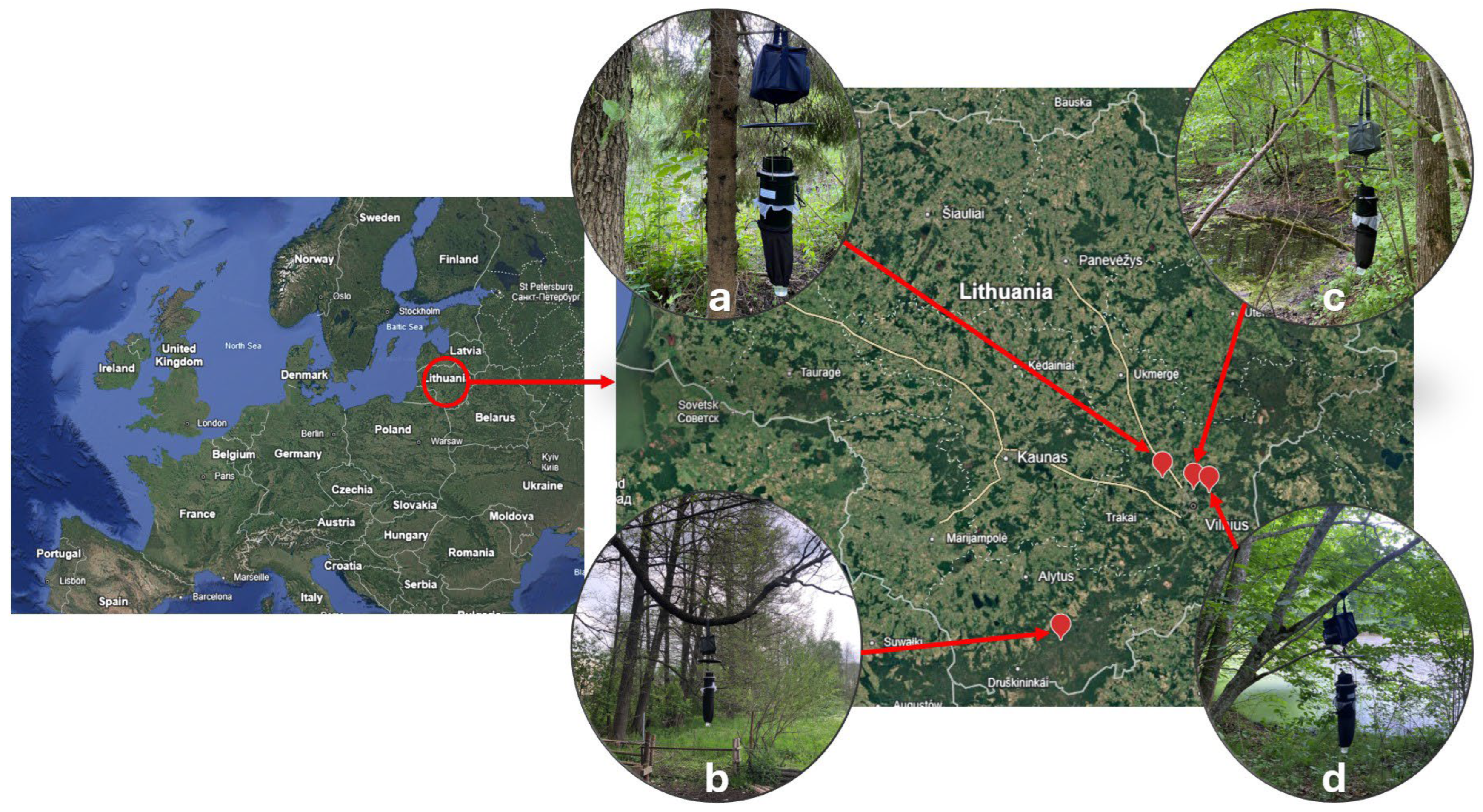
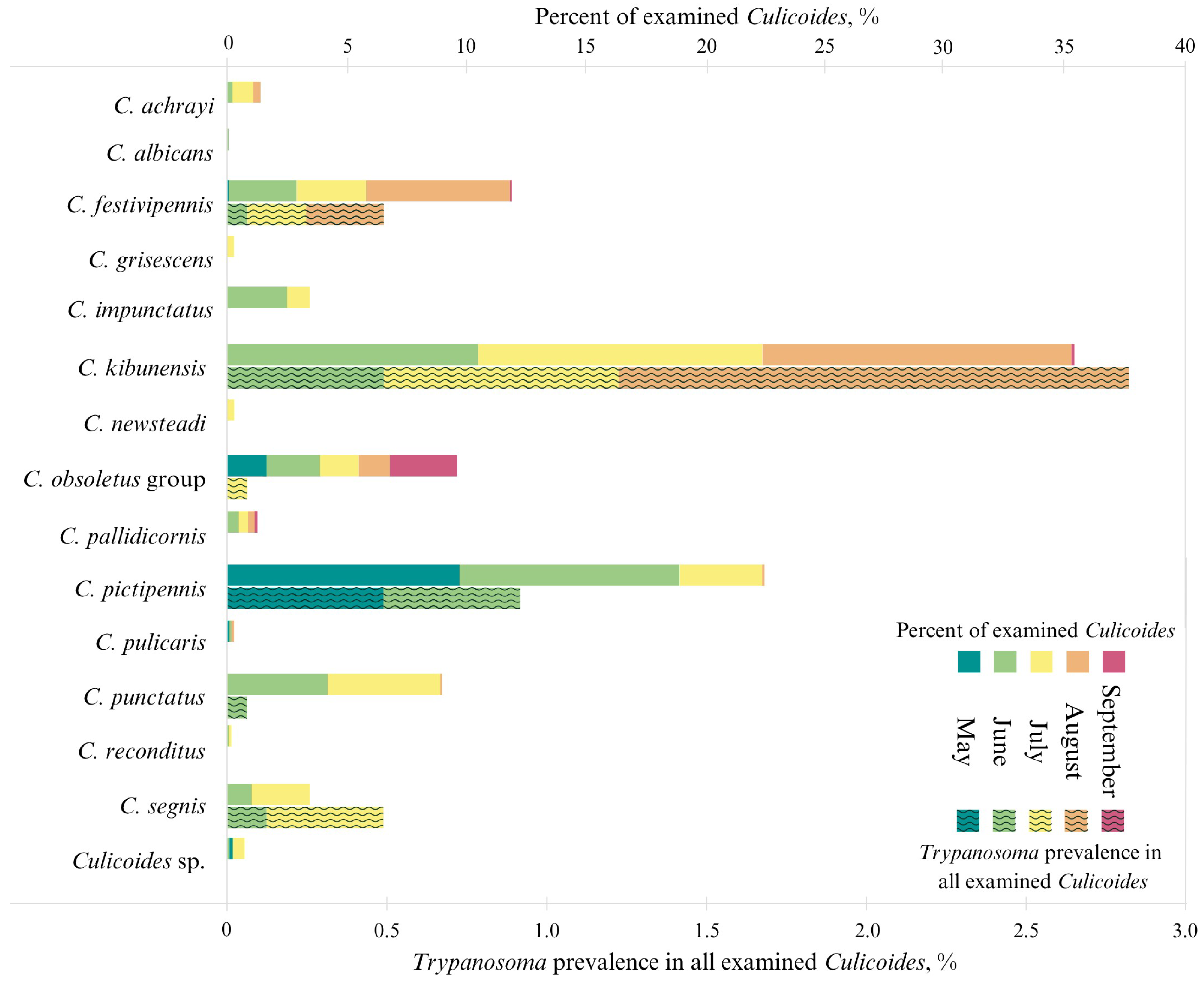


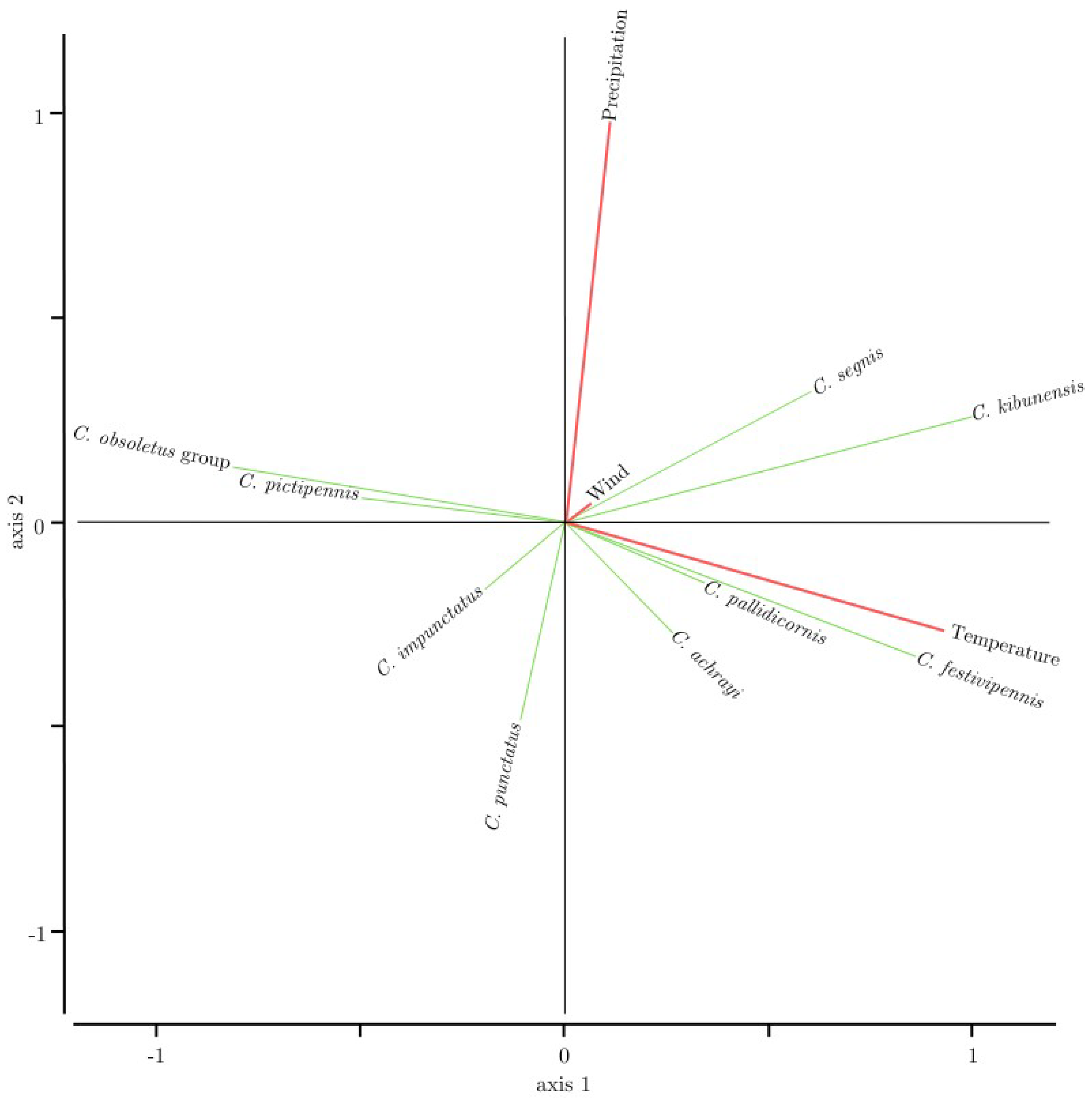
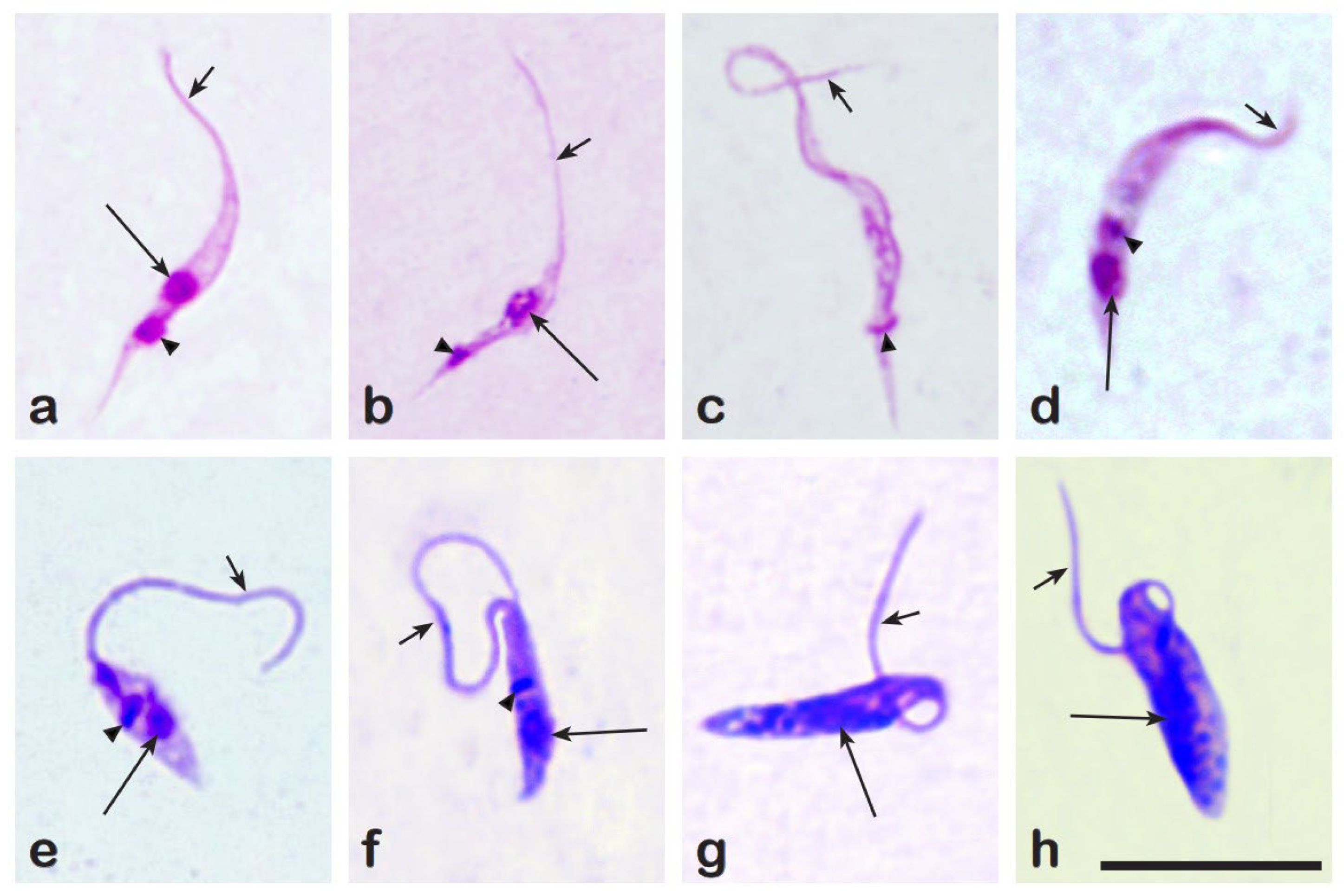
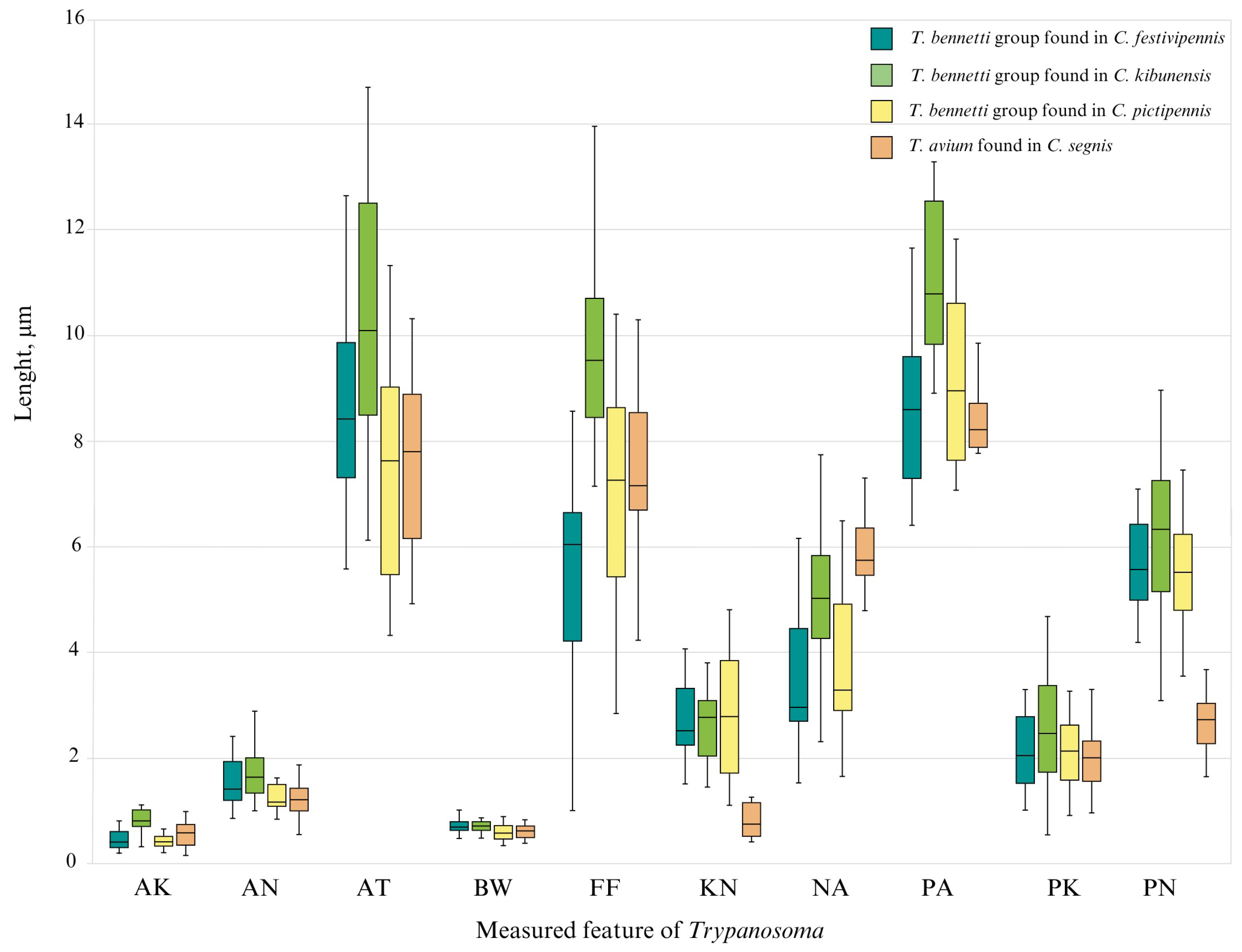

| Primer Name | Sequence 5′–3′ | Expected Amplicon Size | References |
|---|---|---|---|
| LCO 1490 (forward) | GGTCAACAAATCATAAAGATATTGG | ~600 bp | Folmer et al., 1994 [46] |
| HCO 2198 (reverse) | TAAACTTCAGGGTGACCAAAAAATCA | ~600 bp | |
| TRYP 763 (forward) | CATATGCTTGTTCAAGGAC | ~1000 bp | Sehgal et al., 2001 [45], Valkiūnas et al., 2011 [43] |
| TRYP 1016 (reverse) | CCCCATAATCTCCAATGGAC | ~1000 bp | |
| TRYP 99 (forward) | TCAATCAGACGTAATCTGCC | ~700 bp | |
| TRYP 957 (reverse) | CTGCTCCTTTGTTATCCCAT | ~700 bp |
| May | June | July | August | September | Total no. of Parasites (n Dixenous/n Monoxenous) | |
|---|---|---|---|---|---|---|
| Culicoides obsoletus group | Herpetomonas ztiplika (1) | H. ztiplika (1) T. theileri group (1) | T. bennetti group (1) | H. ztiplika (2) | H. ztiplika (1) | 2/5 |
| C. pictipennis | Trypanosoma bennetti group (8) | H. ztiplika (2) T. bennetti group (7) Crithidia brevicula (1) | H. ztiplika (1) C. brevicula (2) | 15/6 | ||
| C. impunctatus | C. brevicula (1) T. theileri group (1) | C. brevicula (4) | 1/5 | |||
| C. segnis | T. avium (2) | T. avium (5) Trypanosoma sp. (1) | 8/3 | |||
| C. brevicula (3) | ||||||
| C. punctatus | H. ztiplika (2) T. theileri group (1) | 1/2 | ||||
| C. kibunensis | T. bennetti group (5) T. theileri group (1) T. avium (1) | T. bennetti group (13) T. theileri group (1) | T. bennetti group (23) T. theileri group (1) Trypanosoma sp. (2) | 47/0 | ||
| C. newsteadi | C. brevicula (1) | 0/1 | ||||
| C. festivipennis | T. bennetti group (1) | Trypanosoma sp. (1) T. bennetti group (2) | T. bennetti group (4) | 8/0 | ||
| C. achrayi | C. brevicula (1) | 0/1 | ||||
| C. grisescens | C. brevicula (1) | 0/1 | ||||
| Culicoides sp. | C. brevicula (1) | 0/1 |
| Feature | Measurements (µm) | |||
|---|---|---|---|---|
| C. festivipennis | C. kibunensis | C. pictipennis | C. segnis | |
| T. bennetti gr. (n = 18) | T. bennetti gr. (n = 20) | T. bennetti gr. (n = 18) | T. avium (n = 17) | |
| AK | 0.2–0.9 (0.5 ± 0.2) | 0.3–1.7 (0.9 ± 0.4) | 0.2–0.8 (0.4 ± 0.1) | 0.2–1.4 (0.6 ± 0.3) |
| AN | 0.9–2.4 (1.5 ± 0.4) | 1.0–2.9 (1.7 ± 0.5) | 0.8–2.8 (1.3 ± 0.4) | 0.6–2.7 (1.3 ± 0.5) |
| AT | 5.6–12.6 (8.6 ± 1.8) | 6.1–14.7 (10.3 ± 2.6) | 4.3–11.3 (7.4 ± 2.1) | 4.9–10.3 (7.6 ± 1.6) |
| BW | 0.5–1.1 (0.7 ± 0.2) | 0.5–1.1 (0.7 ± 0.1) | 0.4–0.9 (0.6 ± 0.2) | 0.4–0.8 (0.6 ± 0.1) |
| FF | 1.0–8.6 (5.5 ± 1.9) | 7.1–14.0 (9.8 ± 1.7) | 2.8–10.4 (6.8 ± 2.1) | 4.2–10.3 (7.5 ± 1.5) |
| KN | 1.5–4.1 (2.7 ± 0.7) | 1.5–3.8 (2.6 ± 0.6) | 1.1–4.8 (3.0 ± 1.2) | 0.5–2.4 (0.9 ± 0.5) |
| NA | 1.5–6.2 (3.5 ± 1.3) | 2.3–7.7 (5.0 ± 1.3) | 1.7–6.5 (3.6 ± 1.3) | 3.6–7.3 (5.8 ± 0.9) |
| PA | 6.4–13.7 (8.8 ± 2.0) | 8.9–13.3 (11.1 ± 1.4) | 7.1–11.8 (9.3 ± 1.7) | 6.5–9.9 (8.3 ± 0.8) |
| PK | 1.0–3.3 (2.1 ± 0.7) | 0.5–4.7 (2.6 ± 1.2) | 0.9–3.3 (2.1 ± 0.7) | 1.0–4.7 (2.2 ± 0.9) |
| PN | 2.5–7.1 (5.5 ± 1.1) | 3.1–14.9 (6.6 ± 2.4) | 3.6–7.5 (5.6 ± 1.1) | 1.7–3.7 (2.7 ± 0.5) |
| AN/AT | 0.1–0.3 (0.2 ± 0.04) | 0.1–0.3 (0.2 ± 0.1) | 0.1–0.3 (0.2 ± 0.06) | 0.1–0.3 (0.2 ± 0.1) |
| BW/PA | 0.04–0.2 (0.09 ± 0.03) | 0.05–0.1 (0.1 ± 0.01) | 0.04–0.1 (0.06 ± 0.01) | 0.05–0.1 (0.1 ± 0.01) |
| PK/PA | 0.1–0.5 (0.3 ± 0.1) | 0.1–0.5 (0.2 ± 0.1) | 0.1–0.5 (0.2 ± 0.1) | 0.1–0.6 (0.3 ± 0.1) |
| PN/KN | 1.1–3.4 (2.1 ± 0.6) | 1.6–7.5 (2.7 ± 1.4) | 1.4–4.5 (2.1 ± 0.8) | 1.1–6.4 (3.6 ± 1.6) |
| PN/NA | 0.6–3.3 (1.8 ± 0.7) | 0.6–3.5 (1.4 ± 0.7) | 0.6–3.7 (1.7 ± 0.7) | 0.3–0.8 (0.5 ± 0.1) |
| PN/PA | 0.3–0.8 (0.6 ± 0.1) | 0.3–1.4 (0.6 ± 0.2) | 0.3–0.8 (0.6 ± 0.1) | 0.2–0.4 (0.3 ± 0.1) |
Disclaimer/Publisher’s Note: The statements, opinions and data contained in all publications are solely those of the individual author(s) and contributor(s) and not of MDPI and/or the editor(s). MDPI and/or the editor(s) disclaim responsibility for any injury to people or property resulting from any ideas, methods, instructions or products referred to in the content. |
© 2025 by the authors. Licensee MDPI, Basel, Switzerland. This article is an open access article distributed under the terms and conditions of the Creative Commons Attribution (CC BY) license (https://creativecommons.org/licenses/by/4.0/).
Share and Cite
Kazak, M.; Valavičiūtė-Pocienė, K.; Bernotienė, R. The Study on Culicoides: The Environment They Live in and Trypanosomatids They Coexist. Insects 2025, 16, 770. https://doi.org/10.3390/insects16080770
Kazak M, Valavičiūtė-Pocienė K, Bernotienė R. The Study on Culicoides: The Environment They Live in and Trypanosomatids They Coexist. Insects. 2025; 16(8):770. https://doi.org/10.3390/insects16080770
Chicago/Turabian StyleKazak, Margarita, Kristina Valavičiūtė-Pocienė, and Rasa Bernotienė. 2025. "The Study on Culicoides: The Environment They Live in and Trypanosomatids They Coexist" Insects 16, no. 8: 770. https://doi.org/10.3390/insects16080770
APA StyleKazak, M., Valavičiūtė-Pocienė, K., & Bernotienė, R. (2025). The Study on Culicoides: The Environment They Live in and Trypanosomatids They Coexist. Insects, 16(8), 770. https://doi.org/10.3390/insects16080770









